How to Fluff Pillows & Cushions
Saggy, lumpy, tons of wrinkles. While these qualities may be cute on a bulldog puppy, they aren’t so hot on your furniture. Over time, your once pristine and buoyant sofa might start exhibiting this telltale droop. You could just burn the whole thing to the ground — or you could learn how to fluff pillows.
Fluff pillows? Pfft. Anyone can do that. While this is probably true, there is a serious art to fluffing contemporary pillows & couch cushions properly. Just like the art of a precise skincare routine, a pillow-fluffing regimen can lead to a longer-lasting, more youthful sofa. To make sure your cushions stay perfectly perky, we asked our in-house experts for their professional tips. Let’s get fluffing.
The necessity of fluffing pillows.
Your couch and lounge chair cushions work hard. They deserve a little pampering from time to time.
The materials used in most soft furniture padding, such as feather down, foam, and polyester filling (otherwise known as “poly fill”), naturally change shape over time. You might notice that your favorite spot on the sofa has a bit of a dip or indent from your preferred Netflix watching location. Your armchair’s back cushion might be caving in where your pet loves to snooze. Whatever the case, it’s normal to see this kind of shape shifting with regular use.

This doesn’t mean you’re destined to a life of furniture that looks like its seen one too many late nights. When you regularly fluff your pillows and cushions, you instantly breathe life back into your piece. It might just be the easiest room refresh possible.
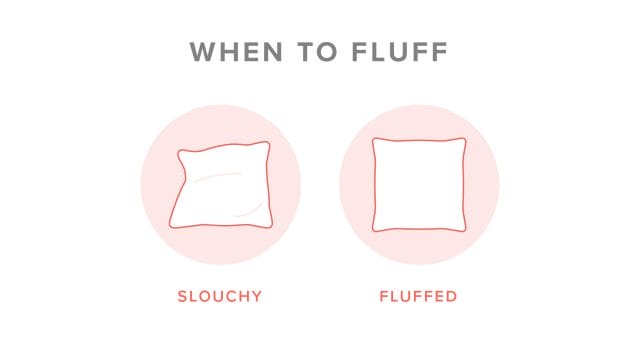
Regular maintenance and fluffing can also help extend the lifetime of your sofa. By helping the filling disperse evenly, all areas of the cushions receive equal wear. The extra body and thickness gives the frame of your sofa additional protection from rubbing and wear — kind of like airbags for the rest of your couch. Remember: a plump cushion is a stronger cushion.
Not only will pillow fluffing make your space look better, it will feel better. You’ll notice a big change in the support you’re getting from the back cushions. Your tushy will thank you when it feels those newly fluffed seat cushions.
Different Fluff. Different Needs.
Various modern sectional sofas and armchair designs have different fluffing needs. It’s important to think about how much time you’re willing to dedicate to fluffing your cushions before you purchase a piece of furniture.
Because of their extraordinary softness, down and feather blend cushions will require more regular fluffing than other types of filling. If you know that you aren’t going to stick to a good fluffing schedule, it’s better to invest in a firmer sofa.
For example, our Quadra sofa has a thoughtful combination of springs and webbing to give it the softness you want from a sofa — without the need for constant fluffing.
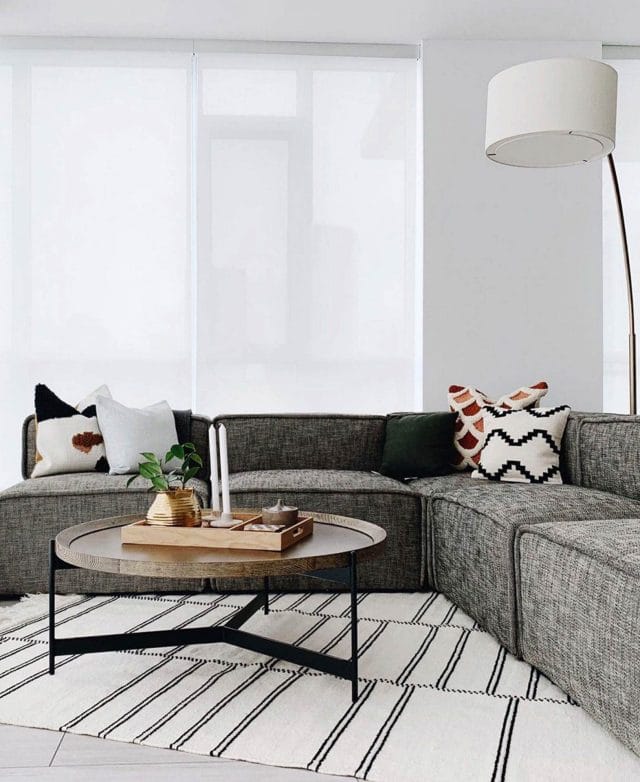
If you want a more pillowy look, the Solae sofa has a down and feather-filled duvet that’s expertly sewn into the layers of filling. You’ll get the plushness and relaxed look of a feather filling, but it’ll be contained into manageable areas. Just how we like it.
How to fluff pillows like an expert.
It’s time to get ‘down’ to the fun stuff: the fluffing.
When it comes to feather down, foam, and poly fill pillows, the first thing you want to do is remove all the cushions from the sofa or armchair. Place these in a clean spot. Once these are off, take this opportunity to vacuum out all those fun little crevices.
Flip It and Reverse It.
If you have reversible cushions — ones where the material on the back is the same as the front — there’s a quick and easy way to freshen things up.
Once you’ve given your couch or armchair a quick vacuum, flip and rotate the cushions. We recommend flipping and rotating your pillows about once a week. The goal here is to switch up the sitting ‘hot spots.’ Every cushion deserves to be the popular guy for awhile.
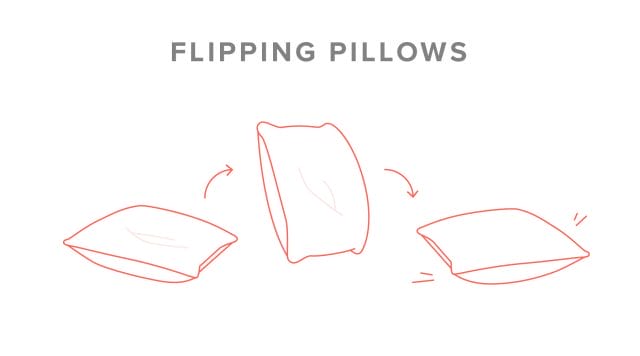
Get It All Out.
Now it’s finally time to fluff. Start by finding a midpoint on each cushion’s side. Start pushing in and hitting the sides quickly and with some gusto. Once you’ve done the sides, move onto the rest of the pillow in a bottom to top movement.
Hit and punch it with some force to make sure the filling is being dispersed and fluffed up. Here, you can also use a tool to help with the fluffing. For example, a stocking or long sock full of tennis balls makes a great fluffing partner. We don’t condone violence, but pillows don’t have feelings. These fluffing methods will give you beautiful cushions — and help with any pent up anger or frustration you might be feeling. Win-win.
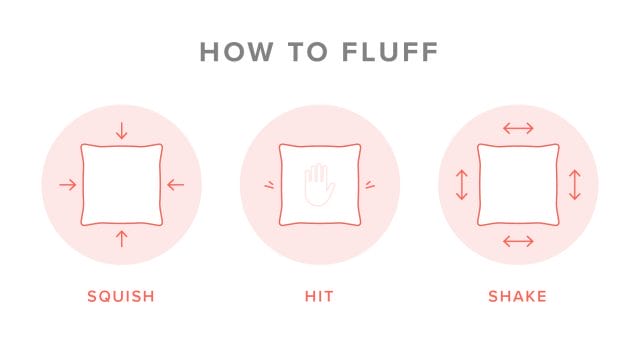
Continue the free therapy session by taking each cushion, grabbing onto the edges, and shaking aggressively. Put on your favorite heavy metal tunes and just go at it. Friendly suggestion: you might want to close the curtains for this one. While quite the sight, this rough and tumble approach is highly recommended by our furniture experts as a surefire way to make your cushions and pillows sing anew.
Bench Seat Fluffing.
The techniques above work well for removable cushions, but some modern benches and lounge chairs have solid and sewn-in seats.
You can still apply the punching method for these pieces; it’ll just look a little different. To start, simply punch and bang at the seat and back of the sofa or armchair. Move from one end of the piece to the other end to ensure a uniform result.
Once you’ve sufficiently punched, find the center of the seat. With your palm down, smooth the fabric from the center point to the edges. If you notice excess fabric, tuck it into the corners and cracks of the frame. You should now be able to bounce a dime off of your seat cushion.

The Great Debate: How to Fluff Throw Pillows.
We were all born with certain preferences: salty or sweet; dogs or cats; karate chopped throw pillow or naturally relaxed throw pillow. Karate chopped pillows have become all the rage over the last decade or so, with designers slinging their firm palms to cushions like their aesthetic depends on it.

To achieve the chopped pillow look, fluff your feather or down-filled pillow and use a chopping motion to create an indented V shape in the middle. Zhush the pillow a bit by holding onto the points of each ‘ear’ until you reach your desired shape. These chopped pillows can help a room look neat and tidy. With their perfectly plumped and contrived shape, they add extra interest and sophistication to a space. Basically, they represent the thought and care you’ve put into creating a comfortable and stylish space.
We would be doing our readers a disservice if we didn’t mention there are diehard pillow chopping protestors. They believe the karate chopped look is too ‘perfect’ and manipulated. If you find yourself nodding along, you’re probably more into the natural throw pillow plumping look. A gentle fluff of your favorite pillows is all you need to feel on top of the world. The pillow world.
Remember: whichever pillow fluffing style you prefer, you were born this way.
Pillow Fluffing Do’s and Don’ts
With all the shaking, punching, and karate chopping, it’s easy to get carried away when figuring out how to fluff pillows. To make sure you’re doing what’s best for your cushions — and yourself — we’ve summed up our expert tips.
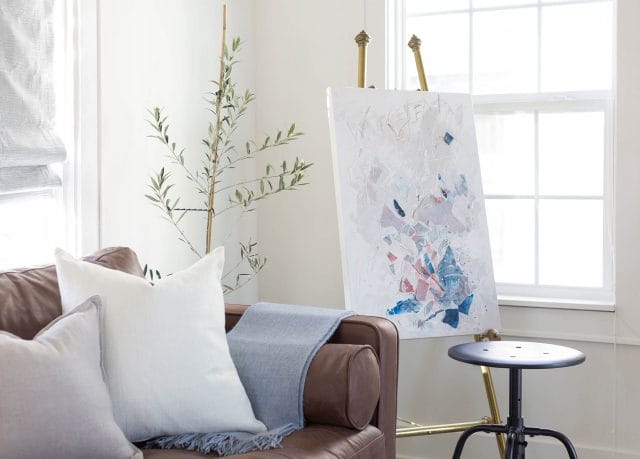
Do:
- Flip and rotate. The first step in making your pillows look their best is with regular rotations and flipping.
- Smack, punch, and hit. Get all your pent up frustrations out — for a good cause. Pillows love a good game of rough and tumble.
- Evenly distribute your fluffing. Make sure you aren’t hitting one area of the cushion and forgetting about the other side. All sides are equal.
- Give equal attention to throw pillows. Finish off your refreshed look by fluffing and puffing up your throw pillows. Karate chop, leave them smooth, or mix and match.
Don’t:
- Open up any tight-fitting zippers. It’s often said that you should unzip and open up the cushions to ‘let them breathe.’ This works for softer cushions, but we do not recommend opening up any zippers on tight-fitting cushions as it can be very difficult to get the filling back in without busting a zipper or seam.
- Use any sharp objects. Fluffing should be a victimless occasion. Make sure you aren’t wearing any jewelry while fluffing your pillows. Keep keys, pocket knives, pens, or other sharp objects out of the cushion fluffing vicinity. It’s also a good idea to keep long and pointy fingernails away from your pillow fluffing party. Good for your pillow. Good for your manicure.
- Use the wrong insert. If your throw pillow insert is too small for the cushion cover, no amount of fluffing will give that thing life. If bought separately, make sure your pillow inserts are the correct size for the cover.
Learning how to fluff cushions is an art. Now that we’ve taken you through our expert guide, you can officially call yourself a certified pillow fluffer. Update that LinkedIn profile, baby.

